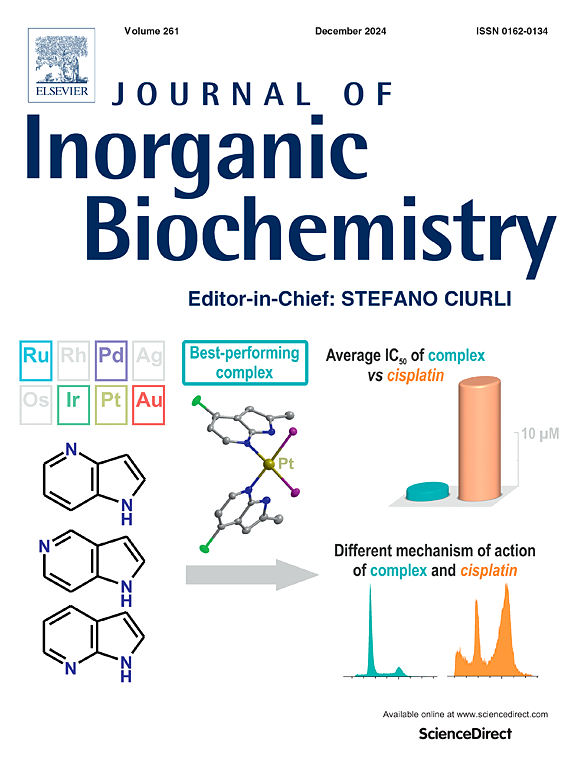以咪唑盐取代1,10-邻菲罗啉的钌(II)芳烃配合物:合成及细胞毒性活性
IF 3.8
2区 化学
Q2 BIOCHEMISTRY & MOLECULAR BIOLOGY
引用次数: 0
摘要
研究人员越来越关注于开发靶向性、高细胞选择性、亲脂性、水溶性的Ru(II)芳烃配合物,以减轻市售铂基抗癌药物的副作用。在这种情况下,我们提出了新的Ru(II)芳烃配合物(Ru1和Ru1a-f),它们基于1,10-菲罗啉取代的咪唑核心,由烷基(丁基(a),辛基(b),十二烷基(c))或苄基((苄基(d), 2,4,6-三甲基苄基(e),五甲基苄基(f))衍生。采用1H、13C、19F和31P核磁共振(NMR)谱、傅里叶变换红外光谱、质谱和元素分析对配合物的结构进行了表征。研究了Ru1和Ru1a-f复合物对MCF-7、MDA-MB-231和mcf - 10a等正常细胞株的细胞毒活性。与IC50浓度的Ru1c复合物孵育72h后,MCF-7和MDA-MB-231乳腺癌细胞株的细胞周期分布可有效抑制细胞在G2/M期的生长。流式细胞术分析显示,Ru1c复合物诱导MCF-7和MDA-MB-231乳腺癌细胞凋亡。此外,利用紫外可见光谱分析了Ru1c复合物与鱼-鲑鱼DNA的结合模式。用吸收法分析了Ru1c配合物与牛血清白蛋白的相互作用。所有配合物在溶剂中的稳定性用1H NMR谱法进行了评价。此外,通过电感耦合等离子体质谱(ICP-MS)定量测定细胞内总钌水平。进行分子对接,评估Ru1c与参比药物顺铂对CDK1、cyclin B1、Bcl-xL和Bcl-2蛋白的相互作用残基和对接评分。本文章由计算机程序翻译,如有差异,请以英文原文为准。

Ruthenium(II) arene complexes bearing 1,10-phenanthroline substituted with an imidazolium salt: Synthesis, and cytotoxic activities
Researchers are increasingly focusing on developing target-specific, highly cytoselective, lipophilic, water-soluble Ru(II) arene complexes to mitigate the side effects of commercially available platinum-based anticancer drugs. In this context, we present novel Ru(II) arene complexes, (Ru1 and Ru1a-f), which are based on a 1,10-phenanthroline-substituted imidazolium core derivatized with alkyl (butyl(a), octyl(b), dodecyl(c)) or benzyl ((benzyl(d), 2,4,6-trimethylbenzyl(e), pentamethylbenzyl(f)) groups. The structures of these complexes were characterized using 1H, 13C, 19F and, 31P nuclear magnetic resonance (NMR) spectroscopy, Fourier transform infrared spectroscopy, mass spectrometry and elemental analysis. The cytotoxic activities of Ru1 and Ru1a-f complexes were tested against the cancer cell lines MCF-7 and MDA-MB-231 and normal cell lines, such as MCF-10 A. The cell cycle distribution in the MCF-7 and MDA-MB-231 breast cancer cell lines after 72 h of incubation with IC50 concentration of the complex Ru1c can validly inhibit cell growth in the G2/M phase. Flow cytometry analysis showed that the complex Ru1c induced apoptosis in MCF-7 and MDA-MB-231 breast cancer cells. Additionally, the binding mode of the complex Ru1c with Fish-Salmon DNA was examined using ultraviolet-visible spectroscopy. Interaction of Ru1c complex with bovine serum albumin was analyzed by absorption study. The stability of all complexes in the solvent was assessed using 1H NMR spectroscopy. Additionally, quantitative determination of the total ruthenium level within the cells was performed by inductively coupled plasma mass spectrometry (ICP-MS). Molecular docking was performed to evaluate the interaction residues and docking scores of Ru1c and the reference drug cis‑platinum against CDK1, cyclin B1, Bcl-xL and Bcl-2 proteins.
求助全文
通过发布文献求助,成功后即可免费获取论文全文。
去求助
来源期刊

Journal of Inorganic Biochemistry
生物-生化与分子生物学
CiteScore
7.00
自引率
10.30%
发文量
336
审稿时长
41 days
期刊介绍:
The Journal of Inorganic Biochemistry is an established international forum for research in all aspects of Biological Inorganic Chemistry. Original papers of a high scientific level are published in the form of Articles (full length papers), Short Communications, Focused Reviews and Bioinorganic Methods. Topics include: the chemistry, structure and function of metalloenzymes; the interaction of inorganic ions and molecules with proteins and nucleic acids; the synthesis and properties of coordination complexes of biological interest including both structural and functional model systems; the function of metal- containing systems in the regulation of gene expression; the role of metals in medicine; the application of spectroscopic methods to determine the structure of metallobiomolecules; the preparation and characterization of metal-based biomaterials; and related systems. The emphasis of the Journal is on the structure and mechanism of action of metallobiomolecules.
 求助内容:
求助内容: 应助结果提醒方式:
应助结果提醒方式:


